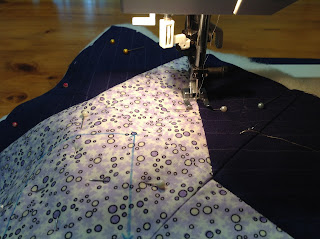And, being a crafty, crazy cat lady, I designed a new Cozy Cat Bed for them to sleep in. It is completely made from fabric. The design allows the sides of the Cozy Cat Bed to squash as Kitty Cat plays on it and then they spring back when he wants to snuggle down for a nap. The pattern is now available in my Craftsy Store. Even though the name is Cozy Cat Bed, it would be a great bed for small dogs too.
Now that the Kitty Cats have a nice new bed, I looked at the fabric scraps on my table and decided to make them a new toy or two. So let's make a fabric mouse for the Kitty Cats to chase.
These little guys are easy to make. You will need:
Scraps of Quilting Cotton
Rotary Cutter
Cutting Mat
Template for Cutting Circles
Strong Thread
Wool Yarn
Toy Filling
Pins
Hand Sewing Needles
Step 1:
Cut a 1/4 circle from your fabrics. I started with a 4 inch square of the floral print and a 2 1/2 inch square of the purple print. I used the Phillips Fiber Art Cut-A-Round to cut the 1/4 circle from each fabric.
Although, I have the mini version of this tool.Step 2:
Pin the two straight edges together, right sides in.
Step 3:
Stitch this edge with a 1/4 inch seam. You can stitch by hand or machine.
Step 4:
Turn the mouse body right side out. The narrow point will be the mouse's nose. Use a blunt object like a pencil to push the nose out.
Step 5:
Thread a hand sewing needle with a double thread and stitch a gathering stitch around the open edge of the mouse.
Step 6:
Fill the mouse firmly with toy filling.
Step 7:
Cut 3 lengths of Wool Yarn for each tail. I cut the Wool Yarn 6 inches long for the small purple mouse and 8 inches long for the larger floral print mouse.
Tie the 3 lengths of yarn together with a knot and then plait them. Finish the plait with a secure knot.
Step 8:
Pull the gathering thread stitched in step 5, until the back of the body is almost closed.
Step 9:
Insert the tail through the opening and pull the thread up firmly. Stitch through the tail and the fabric several times to secure the tail. End off the thread.
If you wish, you can embroider some eyes on the mouse. As you can see, I left the mouse plain. I am impatient to see how Kitty Cat likes them!
I think from the photo below, that Kitty Cat likes his new mouse toy!















































